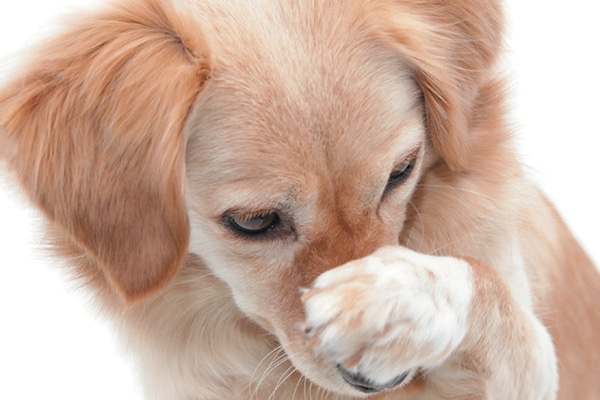One of my favorite things about being part of the Dogster community is getting feedback from our excellent readers I especially love it when a comment on one column leads to a whole new column!
That’s precisely what happened with my recent column, How A Raw Diet Cured What Ailed My German Shepherd Dog. It prompted one Dogster, Cheryl, to write:
Her nose is turning pink, some places look peeled off in patches she has been to the vet, who prescribed titanium dioxide sunscreens, but she lives indoors 90% of the time, year round, and is a lap dog. The vet also said to increase her vitamin E, A, omegas
I feel there is something out there that can do better; I just have not found the right person with the right info. Please, if you have any experience with this dreadful affliction, email me. I thank you and Sieben thanks you.
So, if you fancy any of these breeds, or you’ve adopted a mutt that has one or more of them in its genetic makeup, you’ll want to educate yourself about discoid lupus, and how to cope with it because, if not properly diagnosed and treated, it can cause serious quality-of-life-diminishing discomfort.
Heather Peikes, board-certified dermatologist at NYC’s BluePearl Vet, a 24-hour animal hospital with locations all over the country, explains that the full name of this disease is discoid lupus erythematosus, and it is not related to systemic lupus.
“The symptoms include loss of pigment, redness, scaling or crusting of the nose with loss of the nose’s normal ‘cobblestone’ appearance,” Dr. Peikes says. “Loss of pigment and cobblestone are earlier symptoms; later symptoms include ulceration and crusting, especially when a secondary bacterial infection is present. The most common area to be affected is the nose, but discoid lupus can also affect the bridge of the nose. Less common areas to be affected include around the eyes, the ear flaps, lipfolds, genitals, or anus.”
How does it feel? “Early pigment changes do not lead to discomfort,” she says, “but more chronic cases can be itchy or uncomfortable. If the nose is affected, ulceration close to the blood vessels can lead to bleeding; if the vulva is affected, it can lead to pain when urinating. The most common disease to cause similar symptoms is a bacterial infection that can be localized to mucocutaneous junctions (mucocutaneous pyoderma).”
Treatment involves a course of oral antibiotics for six weeks, based on a culture to rule out skin infection alone. “If the condition is not improving, a skin biopsy is necessary to diagnose discoid lupus; the biopsy usually requires general anesthesia,” Dr. Peikes says. “After treatment, the prognosis is usually good; in mild cases, topical treatment alone may be able to manage symptoms.”
Initially, vets prescribe steroids, then try to use less potent steroids to manage cases. Topical tacrolimus has also been helpful, Dr. Peikes allows, but it can take a few weeks to see improvement. The administration of oral Vitamin E, alone or together with a combination Omega 3/Omega 6 product (such as Nordic Naturals Cod Liver Oil for Pets) may be helpful as an adjunct treatment. The use of drugs that suppress the immune system, such as oral steroids, cyclosporine, azathioprine, or chlorambucil, are only necessary in severe cases that have not responded to prior treatment (or until topical treatments can start to work).
“I remember a dog named Sam, an eight-year-old female Lab who was experiencing nasal ulceration and crusting as well as ulceration of the vulva,” Dr. Peikes says. “We treated her with Vitamin E, Omega 3 and 6, and topical application of tacrolimus. Sam had been very painful when urinating, and was rubbing her nose until bleeding. After treatment, she was a much happier and more comfortable dog.”
Now, here’s the most important caveat of caring for a discoid lupus dog, especially since the breeds that are predisposed happen to be active, outdoorsy types: Sun exposure seriously aggravates symptoms, so sun avoidance and/or sunscreen application is strongly recommended. When selecting UV protection for your pet, read the ingredients, and avoid all products that contain zinc oxide, which is toxic to animals if licked off. A safe bet for preventing and soothing K9 sunburn: The Natural Dog Company’s Snout Soother (SPF 10), a highly emollient blend of shea butter, kukui nut oil, and vitamin E. (Go here for more information on safety for sun-worshiping K9s).
In and out of the sun, supporting an afflicted dog’s skin with emollient balms that are safe and all-natural is kind and smart. Elice Strickland of The Natural Dog Company, maker of the Snout Soother, has received numerous calls from satisfied customers who use it to help their dogs cope with discoid lupus. Meanwhile, neem oil, an extract of the neem tree, has been used for centuries to heal human and animal skin irritations and burns. It is also a natural insect repellent and keeping germ-carrying pests away from the vulnerable nose of a discoid lupus dog is critical to avoid infection.
Compassionate support and prevention can make all the difference between a unhappy K9 and one that copes bravely with this painful condition. If your dog suffers from discoid lupus, consider consulting a veterinarian who practices integrative medicine, since subtle dietary changes and attention to detail are key.
Times of stress, such as subjecting a dog to long-distance travel, might trigger a flare-up. For those instances, respected holistic veterinarian Dr. Michele Yasson of HolVet Holistic Veterinary Services in Kingston, New York, recommends adding a few drops of Rescue Remedy to your dog’s water.
But perhaps most important is implementing what she calls an anti-inflammatory lifestyle: “Feeding an anti-inflammatory diet that contains no grains is imperative, and so is avoiding vaccinations,” Dr. Yasson says. Ask a good homeopathic veterinarian how to maintain a dog with discoid lupus, so that s/he will have the best chance of living a happy, healthy life.
Featured Image Credit: kickers | Getty Images.








